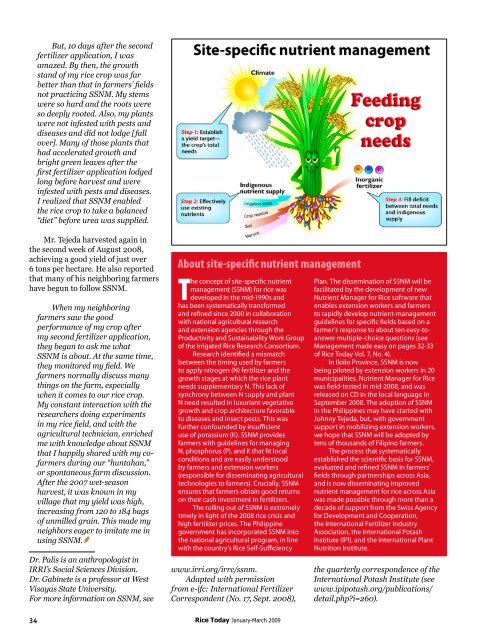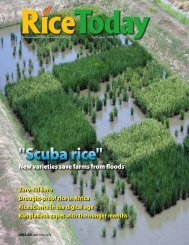How much water does rice need? - adron.sr
How much water does rice need? - adron.sr
How much water does rice need? - adron.sr
You also want an ePaper? Increase the reach of your titles
YUMPU automatically turns print PDFs into web optimized ePapers that Google loves.
But, 10 days after the secondfertilizer application, I wasamazed. By then, the growthstand of my <strong>rice</strong> crop was farbetter than that in farmers’ fieldsnot practicing SSNM. My stemswere so hard and the roots wereso deeply rooted. Also, my plantswere not infested with pests anddiseases and did not lodge [fallover]. Many of those plants thathad accelerated growth andbright green leaves after thefirst fertilizer application lodgedlong before harvest and wereinfested with pests and diseases.I realized that SSNM enabledthe <strong>rice</strong> crop to take a balanced“diet” before urea was supplied.Mr. Tejeda harvested again inthe second week of August 2008,achieving a good yield of just over6 tons per hectare. He also reportedthat many of his neighboring farmershave begun to follow SSNM.When my neighboringfarmers saw the goodperformance of my crop aftermy second fertilizer application,they began to ask me whatSSNM is about. At the same time,they monitored my field. Wefarmers normally discuss manythings on the farm, especiallywhen it comes to our <strong>rice</strong> crop.My constant interaction with theresearchers doing experimentsin my <strong>rice</strong> field, and with theagricultural technician, enrichedme with knowledge about SSNMthat I happily shared with my cofarmersduring our “huntahan,”or spontaneous farm discussion.After the 2007 wet-seasonharvest, it was known in myvillage that my yield was high,increasing from 120 to 184 bagsof unmilled grain. This made myneighbors eager to imitate me inusing SSNM.Dr. Palis is an anthropologist inIRRI’s Social Sciences Division.Dr. Gabinete is a professor at WestVisayas State University.For more information on SSNM, seeAbout site-specific nutrient managementThe concept of site-specific nutrientmanagement (SSNM) for <strong>rice</strong> wasdeveloped in the mid-1990s andhas been systematically transformedand refined since 2000 in collaborationwith national agricultural researchand extension agencies through theProductivity and Sustainability Work Groupof the Irrigated Rice Research Consortium.Research identified a mismatchbetween the timing used by farmersto apply nitrogen (N) fertilizer and thegrowth stages at which the <strong>rice</strong> plant<strong>need</strong>s supplementary N. This lack ofsynchrony between N supply and plantN <strong>need</strong> resulted in luxuriant vegetativegrowth and crop architecture favorableto diseases and insect pests. This wasfurther confounded by insufficientuse of potassium (K). SSNM providesfarmers with guidelines for managingN, phosphorus (P), and K that fit localconditions and are easily understoodby farmers and extension workers(responsible for disseminating agriculturaltechnologies to farmers). Crucially, SSNMensures that farmers obtain good returnson their cash investment in fertilizers.The rolling out of SSNM is extremelytimely in light of the 2008 <strong>rice</strong> crisis andhigh fertilizer p<strong>rice</strong>s. The Philippinegovernment has incorporated SSNM intothe national agricultural program, in linewith the country’s Rice Self-Sufficiencywww.irri.org/irrc/ssnm.Adapted with permissionfrom e-ifc: International FertilizerCorrespondent (No. 17, Sept. 2008),Plan. The dissemination of SSNM will befacilitated by the development of newNutrient Manager for Rice software thatenables extension workers and farmersto rapidly develop nutrient-managementguidelines for specific fields based on afarmer’s response to about ten easy-toanswermultiple-choice questions (seeManagement made easy on pages 32-33of Rice Today Vol. 7, No. 4).In Iloilo Province, SSNM is nowbeing piloted by extension workers in 20municipalities. Nutrient Manager for Ricewas field-tested in mid-2008, and wa<strong>sr</strong>eleased on CD in the local language inSeptember 2008. The adoption of SSNMin the Philippines may have started withJohnny Tejeda, but, with governmentsupport in mobilizing extension workers,we hope that SSNM will be adopted bytens of thousands of Filipino farmers.The process that systematicallyestablished the scientific basis for SSNM,evaluated and refined SSNM in farmers’fields through partnerships across Asia,and is now disseminating improvednutrient management for <strong>rice</strong> across Asiawas made possible through more than adecade of support from the Swiss Agencyfor Development and Cooperation,the International Fertilizer IndustryAssociation, the International PotashInstitute (IPI), and the International PlantNutrition Institute.the quarterly correspondence of theInternational Potash Institute (seewww.ipipotash.org/publications/detail.php?i=260).34 Rice Today January-March 2009

















